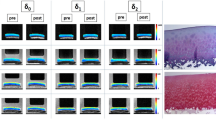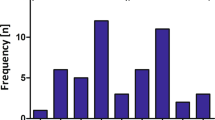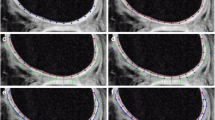Abstract
Objective
Cartilage degeneration involves structural, compositional, and biomechanical alterations that may be detected non-invasively using quantitative MRI. The goal of this study was to determine if topographical variation in T1rho values correlates with indentation stiffness and biochemical contents of human patellar cartilage.
Design
Cadaveric patellae from unilateral knees of 5 donors with moderate degeneration were imaged at 3-Telsa with spiral chopped magnetization preparation T1rho sequence. Indentation testing was performed, followed by biochemical analyses to determine water and sulfated glycosaminoglycan contents. T1rho values were compared to indentation stiffness, using semi-circular regions of interest (ROIs) of varying sizes at each indentation site. ROIs matching the resected tissues were analyzed, and univariate and multivariate regression analyses were performed to compare T1rho values to biochemical contents.
Results
Grossly, superficial degenerative change of the cartilage (i.e., roughened texture and erosion) corresponded with regions of high T1rho values. High T1rho values correlated with low indentation stiffness, and the strength of correlation varied slightly with the ROI size. Spatial variations in T1rho values correlated positively with that of the water content (R2 = 0.10, p < 0.05) and negatively with the variations in the GAG content (R2 = 0.13, p < 0.01). Multivariate correlation (R2 = 0.23, p < 0.01) was stronger than either of the univariate correlations.
Conclusion
These results demonstrate the sensitivity of T1rho values to spatially varying function and composition of cartilage and that the strength of correlation depends on the method of data analysis and consideration of multiple variables.






Similar content being viewed by others
References
Maroudas A. Physico-chemical properties of articular cartilage. In: Freeman MAR, editor. Adult Articular Cartilage. 2nd ed. Tunbridge Wells, England: Pitman Medical; 1979. p. 215–90.
Buschmann MD, Grodzinsky AJ. A molecular model of proteoglycan-associated electrostatic forces in cartilage mechanics. J Biomech Eng. 1995;117:179–92.
Andreoli TE, Bennett JC, Carpenter CCJ, Plum F, Smith LHJ. Cecil essentials of medicine. 3rd ed. Philadelphia, PA: W.B. Saunders Company; 1993.
Praemer A, Furner S, Rice DP. American Academy of Orthopaedic Surgeons. Musculoskeletal conditions in the United States. 1st ed. Park Ridge, Ill.: American Academy of Orthopaedic Surgeons, 1992.
Schumacher HR, Klippel JH, Koopman WJ. Primer on the rheumatic diseases. 10th ed. Atlanta, Ga.: Arthritis Foundation, 1993.
Bollet AJ, Handy JR, Sturgill BC. Chondroitin sulfate concentration and protein-polysaccharide composition of articular cartilage in osteoarthritis. J Clin Invest. 1963;42:853–9.
Mankin HJ, Lipiello L. Biochemical and metabolic abnormalities in articular cartilage from osteoarthritic human hips. J Bone Joint Surg Am. 1970;52-A:424–34.
Squires GR, Okouneff S, Ionescu M, Poole AR. The pathobiology of focal lesion development in aging human articular cartilage and molecular matrix changes characteristic of osteoarthritis. Arthritis Rheum. 2003;48:1261–70.
Sokoloff L. Elasticity of aging cartilage. Proc Fedn Am Socs Exp Biol. 1966;25:1089–95.
Roberts S, Weightman B, Urban J, Chappell D. Mechanical and biochemical properties of human articular cartilage in osteoarthritic femoral heads and in autopsy specimens. J Bone Joint Surg Br. 1986;68-B:278–88.
Kempson GE, Freeman MAR, Swanson SAV. The determination of a creep modulus for articular cartilage by indentation tests of the human femoral head. J Biomech. 1971;4:239–50.
Kempson GE, Muir H, Pollard C, Tuke M. The tensile properties of the cartilage of human femoral condyles related to the content of collagen and glycosaminoglycans. Biochim Biophys Acta. 1973;297:456–72.
Kempson GE. Mechanical properties of articular cartilage. In: Freeman MAR, editor. Adult Articular Cartilage. 2nd ed. Tunbridge Wells, England: Pitman Medical; 1979. p. 333–414.
Chung CB, Frank LR, Resnick D. Cartilage imaging techniques: current clinical applications and state of the art imaging. Clin Orthop Relat Res. 2001;(391):370–378.
Duvvuri U, Reddy R, Patel SD, Kaufman JH, Kneeland JB, Leigh JS. T1rho-relaxation in articular cartilage: effects of enzymatic degradation. Magn Reson Med. 1997;38(6):863–7.
Burstein D, Velyvis J, Scott KT, Stock KW, Kim YJ, Jaramillo D, et al. Protocol issues for delayed Gd(DTPA)(2-)-enhanced MRI (dGEMRIC) for clinical evaluation of articular cartilage. Magn Reson Med. 2001;45(1):36–41.
Bae WC, Temple MM, Amiel D, Coutts RD, Niederauer GG, Sah RL. Indentation testing of human cartilage: sensitivity to articular surface degeneration. Arthritis Rheum. 2003;48(12):3382–94.
Collins DH. The pathology of articular and spinal disease. London: Arnold; 1949.
Frank EH, Grodzinsky AJ. Cartilage electromechanics–II. A continuum model of cartilage electrokinetics and correlation with experiments. J Biomech. 1987;20(6):629–39.
Han ET, Busse RF, Li X. 3D segmented elliptic-centric spoiled gradient echo imaging for the in vivo quantification of cartilage T1rho. In: Proceedings of Intl’ Soc Magn Res Med, Miami Beach, FL, USA. 2005.
Buck FM, Bae WC, Diaz E, Du J, Statum S, Han ET, et al. Comparison of T1rho measurements in agarose phantoms and human patellar cartilage using 2D multislice spiral and 3D magnetization prepared partitioned k-space spoiled gradient-echo snapshot techniques at 3 T. AJR Am J Roentgenol. 2011;196(2):W174-179.
Lyyra T, Arokoski JP, Oksala N, Vihko A, Hyttinen M, Jurvelin JS, et al. Experimental validation of arthroscopic cartilage stiffness measurement using enzymatically degraded cartilage samples. Phys Med Biol. 1999;44(2):525–35.
Bae WC, Law AW, Amiel D, Sah RL. Sensitivity of indentation testing to step-off edges and interface integrity in cartilage repair. Ann Biomed Eng. 2004;32(3):360–9.
Farndale RW, Sayers CA, Barrett AJ. A direct spectrophotometric microassay for sulfated glycosaminoglycans in cartilage cultures. ConnectTissue Res. 1982;9:247–8.
Bae WC, Lewis CW, Levenston ME, Sah RL. Indentation testing of human articular cartilage: effects of probe tip geometry and indentation depth on intra-tissue strain. J Biomech. 2006;39:1039–47.
Wheaton AJ, Dodge GR, Elliott DM, Nicoll SB, Reddy R. Quantification of cartilage biomechanical and biochemical properties via T1rho magnetic resonance imaging. Magn Reson Med. 2005;54(5):1087–93.
Regatte RR, Akella SV, Lonner JH, Kneeland JB, Reddy R. T1rho relaxation mapping in human osteoarthritis (OA) cartilage: comparison of T1rho with T2. J Magn Reson Imaging. 2006;23(4):547–53.
Zarins ZA, Bolbos RI, Pialat JB, Link TM, Li X, Souza RB, et al. Cartilage and meniscus assessment using T1rho and T2 measurements in healthy subjects and patients with osteoarthritis. Osteoarthr Cartil. 2010;18(11):1408–16.
Temple MM, Bae WC, Chen MQ, Lotz M, Amiel D, Coutts RD, et al. Age- and site-associated biomechanical weakening of human articular cartilage of the femoral condyle. Osteoarthr Cartil. 2007;15(9):1042–52.
Samosky JT, Burstein D, Eric Grimson W, Howe R, Martin S, Gray ML. Spatially-localized correlation of dGEMRIC-measured GAG distribution and mechanical stiffness in the human tibial plateau. J Orthop Res. 2005;23(1):93–101.
Lyyra T, Jurvelin J, Pitkänen P, Väätäinen U, Kiviranta I. Indentation instrument for the measurement of cartilage stiffness under arthroscopic control. Med Eng Phys. 1995;17:395–9.
Lyyra T, Kiviranta I, Vaatainen U, Helminen HJ, Jurvelin JS. In vivo characterization of indentation stiffness of articular cartilage in the normal human knee. J Biomed Mater Res. 1999;48(4):482–7.
Maroudas A, Venn M. Chemical composition and swelling of normal and osteoarthrotic femoral head cartilage. II. Swelling. Ann Rheum Dis. 1977;36(5):399–406.
Du J, Statum S, Znamirowski R, Bydder GM, Chung CB. Ultrashort TE T1rho magic angle imaging. Magn Reson Med. 2013;69(3):682–7.
Wang N, Xia Y. Anisotropic analysis of multi-component T2 and T1rho relaxations in achilles tendon by NMR spectroscopy and microscopic MRI. J Magn Reson Imaging. 2013;38(3):625–33.
Akella SV, Regatte RR, Wheaton AJ, Borthakur A, Reddy R. Reduction of residual dipolar interaction in cartilage by spin-lock technique. Magn Reson Med. 2004;52(5):1103–9.
Robson MD, Gatehouse PD, Bydder M, Bydder GM. Magnetic resonance: an introduction to ultrashort TE (UTE) imaging. J Comput Assist Tomogr. 2003;27(6):825–46.
Du J, Carl M, Diaz E, Takahashi A, Han E, Szeverenyi NM, et al. Ultrashort TE T1rho (UTE T1rho) imaging of the Achilles tendon and meniscus. Magn Reson Med. 2010;64(3):834–42.
Kim J, Mamoto K, Lartey R, Xu K, Nakamura K, Shin W, et al. Multi-vendor multi-site T(1rho) and T(2) quantification of knee cartilage. Osteoarthr Cartil. 2020;28(12):1539–50.
Bae WC, Malis V, Kassai Y, Miyazaki M. 3D T1rho sequences with FASE, UTE, and MAPSS acquisitions for knee evaluation. Jpn J Radiol. 2023. https://doi.org/10.1007/s11604-023-01453-8.
Li X, Wyatt C, Rivoire J, Han E, Chen W, Schooler J, et al. Simultaneous acquisition of T1rho and T2 quantification in knee cartilage: repeatability and diurnal variation. J Magn Reson Imaging. 2014;39(5):1287–93.
Li X, Han ET, Busse RF, Majumdar S. In vivo T(1rho) mapping in cartilage using 3D magnetization-prepared angle-modulated partitioned k-space spoiled gradient echo snapshots (3D MAPSS). Magn Reson Med. 2008;59(2):298–307.
Bashir A, Gray ML, Hartke J, Burstein D. Nondestructive imaging of human cartilage glycosaminoglycan concentration by MRI. Magn Reson Med. 1999;41:857–65.
Du J, Pak BC, Znamirowski R, Statum S, Takahashi A, Chung CB, et al. Magic angle effect in magnetic resonance imaging of the Achilles tendon and enthesis. Magn Reson Imaging. 2009;27(4):557–64.
Trattnig S, Burstein D, Szomolanyi P, Pinker K, Welsch GH, Mamisch TC. T1(Gd) gives comparable information as Delta T1 relaxation rate in dGEMRIC evaluation of cartilage repair tissue. Invest Radiol. 2009;44(9):598–602.
Borthakur A, Shapiro EM, Beers J, Kudchodkar S, Kneeland JB, Reddy R. Sensitivity of MRI to proteoglycan depletion in cartilage: comparison of sodium and proton MRI. Osteoarthr Cartil. 2000;8(4):288–93.
Newbould RD, Miller SR, Tielbeek JA, Toms LD, Rao AW, Gold GE, et al. Reproducibility of sodium MRI measures of articular cartilage of the knee in osteoarthritis. Osteoarthr Cartil. 2012;20(1):29–35.
Ling W, Regatte RR, Navon G, Jerschow A. Assessment of glycosaminoglycan concentration in vivo by chemical exchange-dependent saturation transfer (gagCEST). Proc Natl Acad Sci U S A. 2008;105(7):2266–70.
Wolff SD, Balaban RS. Magnetization transfer contrast (MTC) and tissue water proton relaxation in vivo. Magn Reson Med. 1989;10(1):135–44.
Schmitt B, Trattnig S, Schlemmer HP. CEST-imaging: a new contrast in MR-mammography by means of chemical exchange saturation transfer. Eur J Radiol. 2012;81(Suppl 1):S144-146.
Haneder S, Apprich SR, Schmitt B, Michaely HJ, Schoenberg SO, Friedrich KM, et al. Assessment of glycosaminoglycan content in intervertebral discs using chemical exchange saturation transfer at 3.0 Tesla: preliminary results in patients with low-back pain. Eur Radiol. 2013;23(3):861–8.
Funding
This article was made possible in part by a grant from Veterans Affairs (I01CX000625-09A1), as well as the National Institute of Arthritis and Musculoskeletal and Skin Diseases of the National Institutes of Health (P30 AR073761). The contents of this paper are solely the responsibility of the authors and do not necessarily represent the official views of the National Institutes of Health or Veterans Affairs.
Author information
Authors and Affiliations
Corresponding author
Ethics declarations
Conflict of interest
The authors declare no competing interests.
Additional information
Publisher's Note
Springer Nature remains neutral with regard to jurisdictional claims in published maps and institutional affiliations.
Rights and permissions
Springer Nature or its licensor (e.g. a society or other partner) holds exclusive rights to this article under a publishing agreement with the author(s) or other rightsholder(s); author self-archiving of the accepted manuscript version of this article is solely governed by the terms of such publishing agreement and applicable law.
About this article
Cite this article
Bae, W.C., Statum, S., Masuda, K. et al. T1rho MR properties of human patellar cartilage: correlation with indentation stiffness and biochemical contents. Skeletal Radiol 53, 649–656 (2024). https://doi.org/10.1007/s00256-023-04458-6
Received:
Revised:
Accepted:
Published:
Issue Date:
DOI: https://doi.org/10.1007/s00256-023-04458-6




